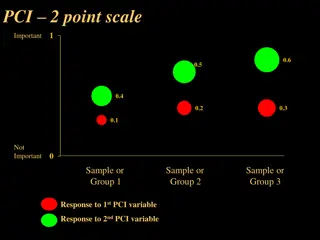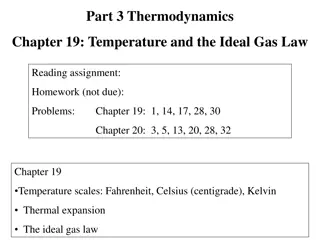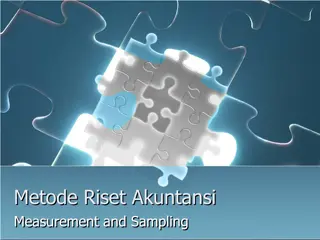Understanding Vernier Scales and Precision Measurement Devices
Vernier scales, named after French cartographer Pierre Vernier, enhance precision in measuring even the smallest scale divisions. Instruments like the theodolite, slide calipers, and Fortin's barometer utilize vernier scales for accurate readings. Learn about key terms like least count and vernier c
5 views • 11 slides
GD Bart Puppy Test: Behavior Scoring System Overview
The GD Bart Puppy Test is a standardized behavioral scoring system designed for puppies at 8 weeks of age, focusing on 21 test components to predict success in canine behavior. Conducted by a team of 3 people, the test evaluates stress signals and responsiveness levels to various stimuli. Multiple e
6 views • 15 slides
WMO Scale of Assessment of Members' Contributions for 2024-2027 Period
The WMO scale of assessment for members' contributions is based on the latest United Nations scales approved by the General Assembly. The scales for the 2024-2027 period will be determined considering the UN scales from the 2021 and 2024 sessions. Adjustments for membership differences will be made,
4 views • 6 slides
Understanding Measurement Scales and Scaling Techniques
Measurement scales play a crucial role in marketing research, with techniques like scaling helping to categorize data. The content discusses four types of measurement scales: nominal, ordinal, interval, and ratio, outlining their characteristics and differences. Scaling techniques involve placing re
5 views • 7 slides
Exploring Melodic Ideas with Pentatonic Scales in Music Composition
Delve into the world of music composition by understanding and utilizing pentatonic scales to develop captivating melodies. Learn key terminology, explore the C pentatonic scale, and discover how major and minor pentatonic scales can influence the mood of your compositions. Dive deep into the power
1 views • 18 slides
Self-Determination Assessment Scoring Guide
Comprehensive step-by-step scoring guides for the AIR Self-Determination Assessment and ARC Self-Determination Scale. The guide includes scoring examples, sections on what students do and feel, and opportunities for self-determination practice. Resources for setting new IEP goals based on assessment
0 views • 27 slides
MCAS Biology Test Scoring Process Overview
Overview of the MCAS test development and scoring process for High School Biology, focusing on constructed-response items. Students are required to write responses to multi-part questions, which are scored holistically with partial credit. The scoring guidelines emphasize the importance of explainin
0 views • 44 slides
Understanding Questionnaires, Scoring, and UAT Part 1
This session focuses on the structure, goals, and content of a User Acceptance Testing (UAT) session related to questionnaires, screening levels, and scoring processes. Participants will receive materials to aid in understanding screening levels, creating questionnaires, and conducting testing scena
0 views • 23 slides
Comprehensive Overview of the Intelligence and Development Scales - Second Edition (IDS-2)
The Intelligence and Development Scales - Second Edition (IDS-2), developed by Dr. Jane Yeomans, is a comprehensive assessment tool for individuals aged 5 to 21. It includes cognitive and general development domains, with subtests covering intelligence scales, executive functions, psychomotor skills
0 views • 25 slides
Understanding Scales in Maps and Plans
Explore the concept of scales in maps and plans, including number scales and bar scales. Learn how to work with different scales, calculate actual distances, and understand the advantages and disadvantages of each scale type. Engage in activities to reinforce your understanding of scales in a practi
0 views • 32 slides
Understanding Tactical Fouls and DOGSO in Soccer
Tactical fouls in soccer involve deliberate acts of foul play to gain an advantage, usually by defenders fouling attacking players. This can prevent scoring opportunities and lead to penalties. On the other hand, DOGSO (Denial of Obvious Goal-Scoring Opportunity) refers to scenarios where a clear go
0 views • 14 slides
AchieveNJ Teacher Evaluation Scoring Guide Overview
This presentation details how districts assess teacher performance in AchieveNJ, outlining the weighting of evaluation elements and explaining the multiple measures used. It covers teacher practice scoring, components weighting, and provides examples for calculating final ratings. Local districts ha
0 views • 24 slides
Overview of RACP Divisional Clinical Examination Scoring Grid and Bands
This presentation provides an in-depth look at the RACP Divisional Clinical Examination, focusing on its purpose, format, pass/fail criteria, and scoring grid. The exam assesses clinical skills and acumen necessary for Basic Physician Training completion. It includes long and short cases rated on a
1 views • 19 slides
Promoting Archery in Hillingdon: Understanding Scoring and Rules
Learn about the scoring system in archery, including point values, line cutters, outdoor shooting details, and indoor scoring rules. Discover how the standard 5-colour face, outdoor rounds, and indoor rounds are scored correctly. Enhance your knowledge on Imperial and Metric scoring systems and the
3 views • 15 slides
Understanding Sequence Alignment and Scoring Matrices
In this content, we dive into the fundamentals of sequence alignment, Opt score computation, reconstructing alignments, local alignments, affine gap costs, space-saving measures, and scoring matrices for DNA and protein sequences. We explore the Smith-Waterman algorithm (SW) for local sequence align
0 views • 26 slides
Speaking Scoring Practice Slides for Secondary Level Assessment
Practice slides for speaking scoring at the secondary level, developed by the Oregon Department of Education in collaboration with the Corvallis School District. These slides aim to simulate an authentic scoring environment and provide training opportunities for Teaching Assistants (TAs) to evaluate
0 views • 14 slides
ELPA21 Screener Speaking Scoring Slides with Rationales
Explore examples of on-the-fly scoring for speaking assessments in ELPA21, created by the Washington State Office of Superintendent of Public Instruction. The images depict scenarios with prompts for scoring based on language proficiency levels, providing insights into student performance during lan
0 views • 9 slides
Salary Study Recommendations Summary
The salary study conducted on February 24, 2015 highlighted certain flaws in the current state of the professional, administrative, classified, and facilities scales. The options presented include creating new scales with a uniform distribution or adjusting existing scales to eliminate frozen steps.
0 views • 13 slides
Supporting Schools and Students: Hand-Scoring & Score Reporting Training Module
This training module series, led by Superintendent Sherri Ybarra, delves into the process of hand-scoring unscored items and modifying machine-generated scores to support schools and students in achieving academic success. It covers accessing tests requiring hand-scoring, utilizing scoring mode and
0 views • 8 slides
Engineering Scale and Different Types of Scales
Engineering scale plays a crucial role in reducing or enlarging dimensions of large or tiny objects to fit standard size drawing sheets. This article covers the concept of reducing scale, representative factor, types of scales like plain, diagonal, vernier, and more, along with detailed construction
0 views • 11 slides
Comprehensive Overview of Point Comparison Importance (PCI) Scales
Explore a detailed examination of various Point Comparison Importance (PCI) scales ranging from 2 to 9 points, each assessing the importance level of different variables. These scales provide insights into respondents' perceptions, with descriptions and sample groups for each scale illustrated in th
0 views • 8 slides
Analysis of Writing Scoring Guide Study Results
This study on writing scoring guide analyzed 594 writing samples using both draft and official scoring rubrics. Results showed varied passing rates between draft and official scoring, with a focus on mean trait scores and agreement levels. The study also delved into sentence fluency editing. Through
0 views • 8 slides
Evaluation Criteria and Scoring Rubric for Arts and Culture Funding Applications
This document outlines the evaluation criteria and scoring rubric for funding applications in the arts and culture sector. It covers the quality of offerings, impact, track record, and other key aspects that will be assessed during the review process. Applicants must demonstrate the quality of their
0 views • 21 slides
Exploring Likert Scale and Survey Examples for Effective Data Collection
Dive into the world of Likert scale with examples for surveys covering agreement, relevance, frequency, importance, quality, likelihood, dichotomous scales, three-point scales, four-point scales, five-point scales, and seven-point scales. Understand the nuances of expressing opinions, preferences, a
0 views • 5 slides
Understanding QuickScore Scoring Guide
QuickScore Scoring Guide explains how scoring is assigned based on user-defined thresholds and breakpoints. Users set values for goals, determine if higher or lower values are better, and establish scoring thresholds for different performance levels. The guide covers various scoring methods, includi
0 views • 10 slides
Implementing the Oregon Official Writing Scoring Guide
The implementation of the Oregon Official Writing Scoring Guide, adopted in Fall 2017, underwent a revision process driven by the adoption of Common Core State Standards. The historical timeline, revision process, and resources for implementing the updated scoring guide are detailed, emphasizing the
0 views • 26 slides
Investigation of the Effects of Automatic Scoring Technology on Human Raters' Performances in L2 Speech Proficiency Assessment
This research explores the impact of automatic scoring technology on human raters in assessing L2 speech proficiency. It aims to compare the performances of expert and non-expert teachers, assess whether providing detailed feedback influences their judgments, and determine how to enhance the collabo
0 views • 20 slides
Understanding Temperature Measurement with Thermometers
Explore the principles of temperature measurement through thermometers, understanding phase changes, behavior of gases, and creating temperature scales. Compare weather forecasts between Moscow and Washington, discussing which city will be warmer and predicting precipitation types. Dive into discuss
0 views • 14 slides
Understanding Temperature Scales and the Ideal Gas Law
This comprehensive guide delves into temperature scales, thermal expansion, and the ideal gas law. Explore the origins of Fahrenheit, Celsius, and Kelvin scales, and learn how to convert between them. Discover the concept of heat, thermal equilibrium, and the Zeroth Law of Thermodynamics. Gain insig
0 views • 14 slides
Comprehensive Overview of Point Contrast Interview Scales
Explore a detailed comparison of various Point Contrast Interview scales ranging from 2-point to 9-point scales. Each scale reflects different levels of favor, action support, uncertainty, and opposition, along with sample responses. The scales provide a structured framework for assessing opinions a
0 views • 8 slides
Mastering Rubrics: Types, Design, and Application
Understand the essentials of rubrics by exploring various types like checklists, rating scales, Likert-type scales, holistic, and analytic rubrics. Learn about the characteristics of good rubrics and how to create effective scoring guides. Get insights from examples like the University of Pittsburgh
0 views • 9 slides
The Important Role of Equivalence Scales in Poverty Dynamics
Equivalence scales play a crucial role in measuring household welfare and poverty dynamics in Russia. This study explores the impact of adjusting scales on poverty lines, chronic poverty, and income mobility using subjective well-being data. The findings reveal higher elasticity for adding adults to
0 views • 26 slides
Development and Evaluation of Harm Reduction Acceptance Scales
Development of scales to measure the acceptance of harm reduction is crucial for understanding public attitudes towards harm reduction strategies. This project focuses on creating valid and reliable scales through a systematic process involving item development, data collection, analysis, and refine
0 views • 15 slides
Understanding Accounting Research Methods: Measurement and Sampling
Measurement is a crucial aspect of research in accounting. It involves assigning numbers to empirical events, objects, or properties. Measurement consists of selecting measurable phenomena, developing mapping rules, and applying these rules appropriately. The process of measurement includes determin
0 views • 63 slides
Efficient Scoring Techniques in Information Retrieval
Today's focus in Information Retrieval is on efficiently scoring and ranking documents matching a query from an inverted index. The goal is to assign scores to each document and select the top K highest scoring ones. Cutting down CPU usage for scoring while maintaining result quality is essential. T
0 views • 18 slides
Explaining How Dragons Glide Through the Skies
Dragons use their wings and scales to glide effortlessly through the sky in search of their next meal. By tilting their wings and adjusting their scales, dragons are able to steer and glide smoothly without flapping their wings constantly. This text focuses on the mechanics of dragon flight, highlig
0 views • 5 slides
Pay Band Adjustments and Scales Update
Changes in pay band structures and scales have been implemented to benefit staff members at the top of their pay bands, those ineligible for pay progression, new starters, and recently promoted employees. Details include adjustments for staff on pay band maximums, removal of minimum points in pay ba
0 views • 4 slides
Understanding Baserunning and Scoring in Baseball
In baseball scoring, account for every base is crucial for tracking offensive and defensive statistics. Baserunners may advance on various plays involving the battery, batter's actions, fielder's choice, errors, and more. Understanding the rules around wild pitches, balks, stolen bases, and passed b
0 views • 19 slides
Understanding Scales and Representative Fractions in Technical Drawings
Scales play a crucial role in technical drawings by representing the ratio of the linear dimensions of an object to its actual dimensions. This text explains the concept of scales, including enlargement and reduction scales, representative fractions (RF), recommended scales by BIS (SP.46: 2003), and
0 views • 29 slides
Understanding Scoring Scales: Meaning, Calculation, and Advantages
Scoring scales are used to assign numerical values to observations for quantifying attributes or behaviors in various fields. They provide a systematic way to evaluate or measure variables, convert qualitative data into quantitative data, and facilitate analysis and interpretation. This article disc
0 views • 22 slides







































